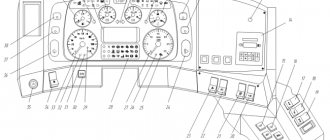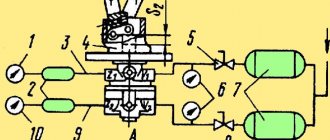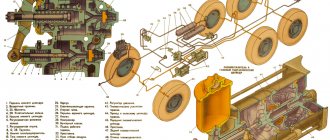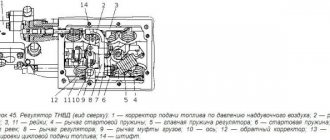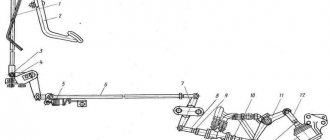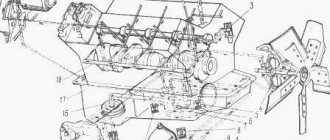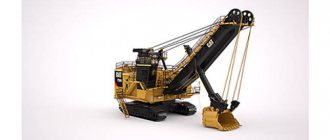Not available:
| № | Part code | Name | Part Information |
| 6422-1018026 | Retainer | Quantity for MAZ-5337 2) MAZ-53371 3) MAZ-54323 4) MAZ-5516 5) MAZ-5551 6) MAZ-64229 1 Model 6422 Group Engine Subgroup Oil lines Serial part number 026 | Not available |
| 6422-1018021 | Sealant | Quantity for MAZ-5337 2) MAZ-53371 3) MAZ-54323 4) MAZ-5516 5) MAZ-5551 6) MAZ-64229 1 Model 6422 Group Engine Subgroup Oil lines Serial part number 021 | Not available |
| 201458 | Bolt M8-6ghx25 | Quantity for MAZ-5337 2) MAZ-53371 3) MAZ-54323 4) MAZ-5516 5) MAZ-5551 6) MAZ-64229 6 Uncoated coating | Not available |
| 6422-1018014-10 | Filler pipe | Quantity for MAZ-5337 2) MAZ-53371 3) MAZ-54323 4) MAZ-5516 5) MAZ-5551 6) MAZ-64229 1 Model 6422 Group Engine Subgroup Oil lines Serial part number 014 Additionally Not interchangeable with the manufactured part previously under the same number | Not available |
| 297580 | Buckle | Quantity for MAZ-5337 2) MAZ-53371 3) MAZ-54323 4) MAZ-5516 5) MAZ-5551 6) MAZ-64229 1 Uncoated coating | Not available |
| 297575 | Cotter pin 5.6x22 | Quantity for MAZ-5337 2) MAZ-53371 3) MAZ-54323 4) MAZ-5516 5) MAZ-5551 6) MAZ-64229 1 Uncoated coating | Not available |
| 252135 | Washer 8T | Quantity for MAZ-5337 2) MAZ-53371 3) MAZ-54323 4) MAZ-5516 5) MAZ-5551 6) MAZ-64229 4 Uncoated coating | Not available |
| 250510 | Nut M8-6N | Quantity for MAZ-5337 2) MAZ-53371 3) MAZ-54323 4) MAZ-5516 5) MAZ-5551 6) MAZ-64229 4 Uncoated coating | Not available |
| 6422-1018025-10 | Bottom bracket | Quantity for MAZ-5337 2) MAZ-53371 3) MAZ-54323 4) MAZ-5516 5) MAZ-5551 6) MAZ-64229 1 Model 6422 Group Engine Subgroup Oil lines Serial part number 025 Additionally Not interchangeable with the manufactured part previously under the same number | Not available |
| 312638 | Washer | Quantity for MAZ-5337 2) MAZ-53371 3) MAZ-54323 4) MAZ-5516 5) MAZ-5551 6) MAZ-64229 2 Uncoated coating | Not available |
| 5336-1018038 | Pad | Quantity for MAZ-5337 2) MAZ-53371 3) MAZ-54323 4) MAZ-5516 5) MAZ-5551 6) MAZ-64229 1 Model 5336 Group Engine Subgroup Oil lines Serial part number 038 | Not available |
| 312326 | Washer 14x19x1.5 | Quantity for MAZ-5337 2) MAZ-53371 3) MAZ-54323 4) MAZ-5516 5) MAZ-5551 6) MAZ-64229 1 Uncoated coating | Not available |
| 5336-1018030 | Pipe with branch pipe | Quantity for MAZ-5337 2) MAZ-53371 3) MAZ-54323 4) MAZ-5516 5) MAZ-5551 6) MAZ-64229 1 Model 5336 Group Engine Subgroup Oil lines Serial part number 030 | Not available |
| 250508 | Nut M6-6N | Quantity for MAZ-5337 2) MAZ-53371 3) MAZ-54323 4) MAZ-5516 5) MAZ-5551 6) MAZ-64229 1 Uncoated coating | Not available |
| 252134 | Washer 6T | Quantity for MAZ-5337 2) MAZ-53371 3) MAZ-54323 4) MAZ-5516 5) MAZ-5551 6) MAZ-64229 1 Uncoated coating | Not available |
| 315407 | Klyammer | Quantity for MAZ-5337 2) MAZ-53371 3) MAZ-54323 4) MAZ-5516 5) MAZ-5551 6) MAZ-64229 1 Uncoated coating | Not available |
| 500-1104540 | Sleeve | Quantity for MAZ-5337 2) MAZ-53371 3) MAZ-54323 4) MAZ-5516 5) MAZ-5551 6) MAZ-64229 1 Model 500 Group Engine power system Subgroup Fuel pipelines Serial part number 540 | Not available |
| 201418 | Bolt M6-6gх16 | Quantity for MAZ-5337 2) MAZ-53371 3) MAZ-54323 4) MAZ-5516 5) MAZ-5551 6) MAZ-64229 1 Uncoated coating | Not available |
| 252037 | Washer 6 | Quantity for MAZ-5337 2) MAZ-53371 3) MAZ-54323 4) MAZ-5516 5) MAZ-5551 6) MAZ-64229 1 Uncoated coating | Not available |
| 297588 | Ribbon | Quantity for MAZ-5337 2) MAZ-53371 3) MAZ-54323 4) MAZ-5516 5) MAZ-5551 6) MAZ-64229 1 Uncoated coating | Not available |
| 5336-1018080 | Dipstick | Quantity for MAZ-5337 2) MAZ-53371 3) MAZ-54323 4) MAZ-5516 5) MAZ-5551 6) MAZ-64229 1 Model 5336 Group Engine Subgroup Oil lines Serial part number 080 | Not available |
A properly functioning MAZ lubrication system increases engine life
The internal combustion engines of multi-ton trucks use the MAZ mixed lubrication system. It is designed to ensure effective lubrication of the parts of the cylinder-piston group of the power unit by spraying and supplying under pressure. In addition, parts are lubricated when oil flows by gravity into the engine crankcase. Motor oil cools bearings and other parts that heat up during friction, and also removes wear products into the oil pan, extending the life of the parts.
Main device of the system
To perform the assigned functions, the MAZ lubrication system consists of the following parts:
- oil filler neck;
- oil pump and oil intake in the oil pan;
- fine and coarse filters;
- cooling radiator;
- safety and pressure relief valve;
- oil channels (mains).
Pressurized oil is supplied through oil lines to lubricate the camshaft main and connecting rod bearings, piston pins, bearings on which the camshaft rotates, rocker arm and pusher bushings, rod ends, as well as the oil pump drive and its bearings. Thanks to the spraying of oil, the mirror surface of the cylinder block liners, camshaft cams, drive gears and rolling bearings is lubricated.
Principle of operation
To create pressure in the line, the oil poured into the engine is sucked by a gear-type oil pump from the sump through a special intake with a filter mesh. The pump consists of a radiator and a discharge (main) section. The discharge part is designed to pump lubricant into the main line through a series-connected filter, which provides rough cleaning. Structurally, the filter is equipped with a bypass valve, which is activated when there is a difference in pressure in the inlet and outlet pipes, which occurs in the event of contamination of the filter element. After opening the valve, the oil flows directly into the line, bypassing the filter element.
After undergoing rough cleaning, the lubricant is pumped into the central line. Next, through special channels made in the cylinder block, it is supplied to the bearings on which the engine crankshaft rotates. Through a system of channels in the crankshaft and connecting rods, oil is pumped under pressure to the camshaft bearings, supplied to the axles of the pushrods and along the rods to lubricate the valve actuators.
A centrifugal-type fine filter element is connected parallel to the main line, through which the lubricant is supplied to the parts of the cylinder-piston group. The element is designed to allow no more than 10% of the lubricant circulating in the system to pass through. After cleaning, the technical fluid is drained into the crankcase (sump) of the power unit. The filter centrifuge is driven by a flow of working fluid under high pressure. The oil, purified by centrifugal force, flows into the oil pan through two nozzles. Mechanical impurities and microparticles are thrown towards the plane of the body and form a sediment. When servicing the filter elements, the resulting contamination is removed.
To cool the working medium circulating in the engine lubrication system, a radiator is connected. An air-cooled tubular type unit is used. It is mounted in front of the radiator of the engine cooling system. The radiator is activated using a special tap. The need for lubricant cooling arises when the truck is operated at air temperatures above 15°C, as well as in severe conditions involving high loads and low speeds.
System protection
In order to ensure stable operation of the MAZ lubrication system, the design includes valves. The pressure reducing valve is installed in the discharge part of the oil pump. Its task is to return the lubricant to the pan at increased pressure at the outlet pipe, exceeding 7.5 kg/sq.cm. A safety valve is mounted in the radiator part of the oil pump. It is adjusted to operate at a pressure of 0.80 -1.2 kg/sq.cm.
The drain valve is mounted at the bottom of the cylinder block and is designed to stabilize the pressure. The device opens when the pressure level in the line reaches 5.0 kg/sq.cm.
Typical faults and troubleshooting methods
When operating a MAZ truck, the following lubrication system malfunctions characteristic of a diesel engine are possible:
- increasing the oil level to a critical value;
- increased lubricant consumption;
- a sharp drop in pressure in the main line;
- smooth reduction in pressure during engine operation.
The main defect of the system is increased or decreased pressure of the circulating oil. The readings are monitored using a pressure indicator mounted on the instrument panel. Before checking parts, you must make sure that the standard measuring device is working properly. For this purpose, a lubricant pressure control indicator is connected to the circuit to verify the readings.
The reason for the lack of pressure may be damage to the pump drive or clogging of the coarse filter elements. Low pressure occurs as a result of low lubrication levels, as well as dilution by coolant or fuel. A decrease in pressure occurs when the oil overheats due to clogging of the radiator or loss of pump performance due to wear of parts.
Loss of pressure is possible due to failure of the oil pump, clogging of the oil receiver in the crankcase or the coarse and fine filters. During long-term operation, natural wear of parts in the friction pairs of the oil pump occurs. If the plunger of the pressure relief or safety valve is stuck, the pressure rises above normal. Also the reason for critically high pressure is the use of high-viscosity lubricant.
During operation, coolant may enter the lubricant due to loss of elasticity of the head gasket and cylinder block. You can determine the presence of fluid by draining a little lubricant from the crankcase into a glass container. After settling for an hour, a transparent layer forms at the bottom, indicating the presence of water. If such a defect is detected, the engine oil must be replaced and further operation of the vehicle is prohibited.
If coolant leaks between the walls of the injector wells and the cylinder head, then when the power unit spins up to 2000 rpm, drops of water form in the area of the injectors. The entry of coolant into the lubrication system is manifested by a sharp increase in the oil level and its dilution.
Engine oil can also thin out due to fuel leakage due to insufficiently tight injector cups. Finding the cause of this malfunction involves dismantling the cylinder head cover and examining the connection points to the injectors of the pipelines through which fuel is drained. Drops of fuel that appear at the junction of the fuel lines after starting and running the engine for 3 minutes indicate system leaks. The defect is eliminated by pressing the pipeline. If no leaks are found at the connection points of the fuel lines, then the injectors are removed and checked for leaks on a special stand.
Reasons for low engine oil levels:
- leakage from damaged seals;
- oil burnout due to worn piston rings;
- clogging of the slots in the oil scraper rings;
- disruption of circulation through the cooling radiator, leading to overheating of the lubricant above 120 ° C;
- the formation of cracks that impair the tightness of the connection between the pipeline flange and the oil pump housing pipe.
Failure of MAZ lubrication system valves is extremely rare due to the insignificant load on these parts. More often valves become clogged (coking) in one of the positions: open or closed. The cause of the defect is the unsatisfactory quality of the oil poured into the engine or the replacement period has been exceeded.
Lubrication system maintenance
To maintain the functionality of parts and structural elements that ensure lubricant pressure in the line and supply it to the rubbing surfaces, it is necessary to perform the following actions as part of routine maintenance:
- Check the engine oil level daily using the dipstick. The check is performed with the power unit not running and the vehicle positioned horizontally. After stopping the engine, at least 5 minutes must pass. If the level is low, the technical fluid is added to the upper mark.
- Visually check that there is no lubricant leakage through the connections of the power unit. In this case, the engine must be warmed up and run for 20 minutes. at 2000 rpm. The bluish color of the exhaust gases indicates combustion of lubricant in the engine cylinders due to wear or sticking of the oil piston rings.
- While driving, constantly monitor the pressure in the line on the dashboard. The normal pressure value on a warm engine is 4-7 kg/sq.cm (minimum 3.5 kg/sq.cm). At idle speed the pressure should not fall below 1 kg/sq.cm (minimum 0.5 kg/sq.cm). If the pressure in the system drops, further operation of the engine is prohibited.
- Change the oil within the time limits specified by the manufacturer. The lubricant is changed when the engine is warm so that particles from rubbing surfaces and dirt are removed along with the oil.
- After filling the crankcase with new lubricant, run the engine for 10 minutes to build up pressure and fill the circuit. After stopping the engine, check the level and add to the upper mark of the oil dipstick. It is necessary to fill in oil according to the season through the oil filler neck.
- If an oil leak is detected during a visual inspection, take measures to replace the sealing elements: gaskets, seals, etc.
When performing service work to change engine oil, it is necessary to flush the filter, which provides coarse cleaning, in the following sequence:
- unscrew the drain plug and drain the waste;
- remove the cap, cover and dismantle the filter element, which is placed in a container with solvent for several hours;
- Wash the removed elements with solvent and blow with compressed air;
- To effectively clean the filter element, place it in a bath with a 10% aqueous solution of caustic soda, rinse thoroughly in diesel fuel and dry with compressed air;
- Assemble the filter and install it on the car.
At each maintenance, it is necessary to disassemble and wash the fine filter. When disassembling and assembling the part, pay attention to the integrity of the cap gasket, rotor, thrust washer, nozzles and the correct position of the mesh. Check the performance of the oil pump on a special stand that simulates operating modes. If during the testing process the pump does not provide the required performance, it must be disassembled and repaired.
With competent and timely routine maintenance of the MAZ lubrication system using high-quality consumables, normal operation of the power unit is ensured and the service life is increased.
Conclusion
The MAZ-543 tractor can rarely be seen in the economic sphere. Its main purpose is military affairs: transporting various trailers, installing weapons and various special modules. Some units received such transport in the form of field housing. They are also armed with vehicles equipped with radar stations that allow them to monitor the air situation. The car is not sold on the secondary market and is not rented. Production still continues, but in small batches and only on government orders.
Source
Design Features
The tractor cabin was designed to accommodate a missile launcher. The use of a classic cabin layout made the vehicle high, which did not allow driving under bridges on public roads. Two strong cabins were made from polyester resin, with the engine compartment between them. Each cabin accommodated 2 passengers. Sound insulation during operation did not allow more than 85 dB of noise to pass through.
MAZ-543 Hurricane was equipped with a riveted-welded frame made of two steel beams, which are fastened with bolts at the intersection. Due to the special design of the frame it was called a “trough”. The disadvantage of this design solution is the slight loss of vehicle clearance. The chassis is equipped with independent suspension. The first two axes are controlled. The brake system was taken from the 537 series.
There were no significant changes in the steering and braking mechanism compared to the MAZ-537. The wheels are equipped with alloy discs. The tire projector was developed for off-road use. Ground clearance - 400 millimeters.
Chassis
Lever-balancer suspension system of a MAZ car
All vehicles of the MAZ-6303 model range use spring suspension with two semi-elliptic springs on the front wheels. In addition, the front suspension includes two double-acting hydraulic shock absorbers. To maintain lateral stability, a special stabilizer is used.
The rear axles of the vehicle use spring-balancer suspension. The springs in such a suspension rest freely on special supports of the bridge beams, and the middle part of the spring is attached to the balancer. This balancer swings on an axis included in a bracket mounted on the car frame.
The machines use a two-stage steering mechanism that has a gear pair and a screw drive. The steering mechanism also includes a distributor built into it. As for the wheels, they are all equipped with drum brakes.
At the same time, the rear wheel tires are made according to a paired scheme - double. The main circuit pneumatic braking system has separate drive to all wheels. The pneumatic drive of the parking brake on the rear wheels uses a spring energy accumulator. The engine exhaust system contains auxiliary compression brake flaps.
History of creation
Experienced engineers were sent from Yaroslavl to the Minsk plant. In 1959, the company was given a new direction of development - the production of universal trucks. The creation and start of production of the successful 537 series showed that special-purpose equipment can be made in Minsk. At the end of the 50s, MAZ received the majority of government orders for the production of military equipment. The craftsmen were given the task of creating a heavy-duty all-wheel drive 4-axle vehicle, a universal wheeled chassis on which military equipment could be installed. After conducting several experiments, the designers decided to opt for a wheelbase, abandoning tracks.
Spare parts for Trucks MAZ-543 (7310)
The Minsk Automobile Plant began producing the MAZ-543 car in 1962. Has a wheel formula of 8x8. The car was used for mounting missile systems, but new combat systems were created on its basis, which made the MAZ-543 the most popular heavy vehicle in the Soviet army. On the website you can buy MAZ-543 spare parts in a special catalog.
MAZ-543 has a hydromechanical transmission with a four-wheel single-stage torque converter and a planetary three-speed gearbox; mechanical two-stage transfer case with center differential, as well as torsion bar suspension and a platform with five folding metal sides. Modifications: MAZ-543A, MAZ-543M. Thanks to our MAZ-543 spare parts catalog, you can easily find all the spare parts you need, because using the catalog is easy and convenient.
Curb weight, kg: 7050. Gross weight, kg: 43300. Loading capacity, kg: 20000. Gross weight of the main trailer, kg: 25000. Engine: D12A-525A, diesel, V-shaped, 12-cylinder. Net engine power, kW (hp): 386.1 (525). Torque, Nm (kgf-m): 2206 (225). Control vehicle fuel consumption, l/100 km, at 60 km/h: 80 (at full load). Maximum speed, km/h: 60. Track, mm: 2375. Ground clearance, mm: 400. Wheelbase, mm: 2200+3300+2200. Dimensions, mm: 11657/3050/2900. Internal dimensions of the platform, mm: 7222/2848/707.
Our specialists will advise you on all questions and tell you about all the MAZ-543 spare parts that are right for you. By purchasing spare parts from Dynamics 76, you are guaranteed to purchase high-quality parts for MAZ.
Modifications
There are several modifications of the 543 model:
- MAZ-543A is a chassis with a payload capacity increased to 22 tons, a cabin moved forward, a frame increased to 7 m and a redesigned compartment for the power unit. The main purpose of the vehicle is to transport Temp missile equipment and 9K58 Smerch multiple rocket launchers.
- MAZ-543P is a tractor with a lifting capacity of 19.6 tons, considered the base model for the 9P117 and 9P120 launch complexes. The vehicle is also used as an airfield fire truck AA-60(543)-160.
- MAZ-543M is a chassis with a lifting capacity of 22.2 tons with a left-hand cab position, an additionally installed engine compartment, and increased space behind the cab. The vehicle transports Smerch, Bereg, Rubezh combat systems, and S-300 anti-aircraft guns.
- MAZ-7930 is a truck with an all-metal body, renamed MZKT-7390, used for transporting weapons systems.
- MAZ-7310 - an on-board module converted into 73101, used with 2-axle tractors MAZ-5433 and 8385 as part of a road train.
